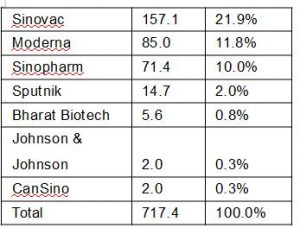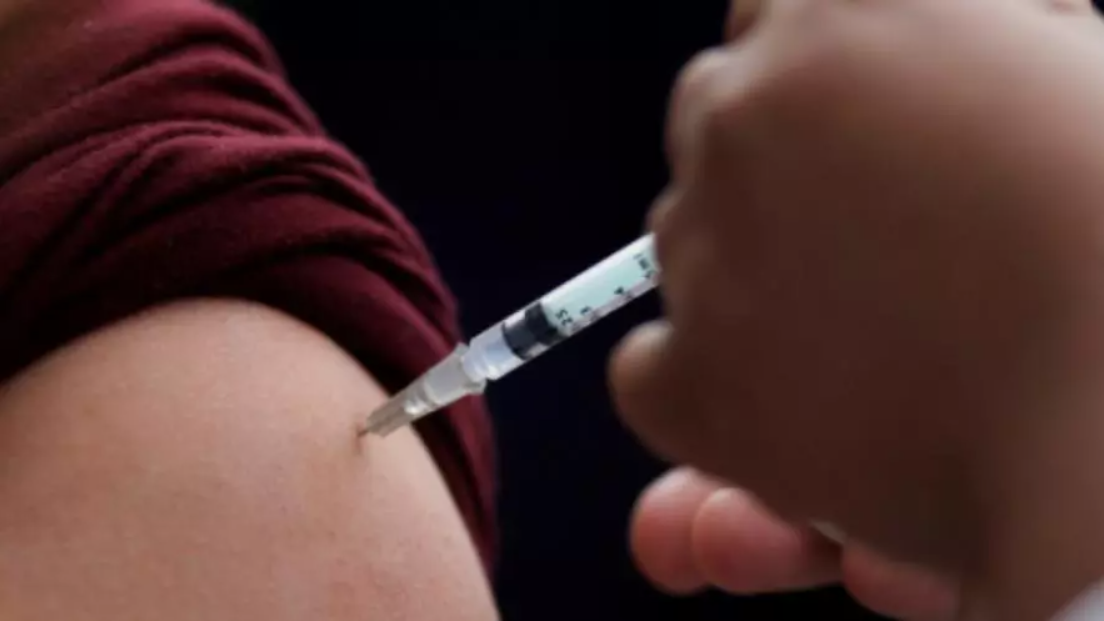With an eighth of the world population, the rich countries—the US, Canada, UK, and the EU—have received more than 50% of the world’s vaccine doses (see Table 1). The US alone has received 147 million vaccine jabs (up to 30 March 2021). This is more than 14 times what the entire continent of Africa—with four times the US population—has received.
And if we do not count the vaccine doses that Morocco, truly an outlier in Africa, has received, the US has received 60 times the vaccine doses that Africa has! No wonder Tedros Ghebreyesus, the WHO Director-General, called the distribution of vaccines “grotesque” and a “catastrophic moral failure”. Let us not call reserving the bulk of vaccines for a handful of rich ex-colonial or settler-colonial states ‘vaccine nationalism’. Let us call it what it is: vaccine apartheid at a global level.
Table 1: Number of vaccine doses injected

(Figures from OurWorldinData up to 30 March, 2021.)
Figures in Table 2 provide the number of vaccine doses produced till 29 March (AirFinity website) by the major vaccine manufacturers. If we ignore the insignificant production at Bharat Biotech, Johnson & Johnson, and CanSino, we see that more than 90% of the current vaccines produced have come from Pfizer, AstraZeneca, Sinovac, Moderna and Sinopharm. Sputnik V is yet to manufacture large quantities, even though it has lined up many companies willing to manufacture the vaccine.
How much of the vaccine manufactured in the rich countries have gone to the rest of the world? The brutal answer is that the rich countries have supplied almost entirely to themselves. Moderna’s production has been entirely for the US. Pfizer has supplied the US from its US facilities and Europe and the UK from its European plants. It has also supplied vaccines to Israel and the Gulf monarchies, but that is a small fraction of its total production.
The rich countries have had some squabbles with each other—the UK and the EU over AstraZeneca supplies, for example. (Perhaps this is why they have had no time for the rest of the world.) If we match the number of doses they have manufactured (see Table 2) with the number of doses used in their own countries, we get an estimate of how much they have supplied to other countries. And as the Economist calculations also show, the rich countries have pretty much kept their vaccine production for themselves.
From where have these other countries—pretty much the rest of the world—got their vaccines? It appears that their only sources of vaccines are those produced in China and India, with Russia providing lesser amounts. This is substantiated by various press sources that recount how countries in Latin America, Eastern Europe and Southeast Asia are receiving supplies from China, India, or Russia.
TABLE 2: NO OF VACCINE DOSES PRODUCED


(Figures from Airfinity website, up to 29 March 2021.)
How much are Sinovac and Sinopharm supplies going to China, and how much to the rest of the world? If we remove the number of doses that China has used (see Table 1), it appears that about 50% of the Chinese production of 230 million doses—about 115 million doses—is used in China and the same amount going to the rest of the world.
Similarly, based on the figures released by the Indian Ministry of External Affairs website on 8 April 2021, 64.5 million doses of the Serum Institute Covishield vaccine—licensed from AstraZeneca—have been exported to other countries. These include bilateral grants, commercial exports and exports to the WHO COVAX platform.
Again, looking at the total number of doses used in India’s vaccination drive—87 million as of 6 April—90% of which is probably Covishield, the doses exported from India are roughly the same order as doses delivered in India. China and India are the only two major countries that have been willing to export vaccines while also vaccinating their own people.
Though India has not halted its vaccine exports, it is currently prioritizing domestic supplies, given a sharp increase in the numbers infected. Its supplies to other countries appear to have slowed down significantly in March and this will impact the COVAX program, particularly in Africa, which is heavily COVAX-dependent.
Sputnik V, developed by the highly respected Gamaleya Institute, has shown efficacy in clinical trials. Ramping up its production has been slow. Russian production capacity of vaccines is not on the scale of Indian and Chinese manufacturers. Though many Indian and South Korean companies are willing to manufacture Sputnik V, they have yet to start or even receive the necessary regulatory clearances. Only one South Korean company—Hankook Korus Pharm—has started producing Sputnik V, though a large consortium of South Korean companies has signed up to manufacture 500 million doses this year. Five Indian companies—Hetero, Gland Pharma, Stelis Biopharma and Virchow Biotech, PanaceaBiotech—have inked deals with the Russian Direct Investment Fund (RDIF) to set up a combined production capacity of 850 million doses.
What prevents the ramping up of vaccine production in India? The Serum Institute of India, the largest vaccine manufacturer in the world, has large supplies of vaccines in stock since it began production even before the Oxford-AstraZeneca vaccine finished its clinical trials. It can produce 100 million Covishield doses per month and more with additional investments. So, why is the Serum Institute unable to increase production? Is it just a shortage of capital? Similarly, why is Biological E, which has a collaboration to produce 600 million doses of the Johnson & Johnson single-jab vaccine (recently approved by the US drug regulator), unable to begin production?
This is where the global media—read the dominant western media—fails to inform people about the real bottlenecks in ramping up production around the world. This is apart from the intellectual property rights issue. The major block to quickly ramp up global vaccine production is the rich countries—the US, UK, and the EU—refusing to export finished vaccines and also supplies of intermediate products and raw materials required to produce vaccines in other countries.
The US is using a 1950 Korean War-vintage Defence Production Act to curb exports of vaccines, raw materials, and other inputs vital for vaccine production elsewhere. The Serum Institute of India, with a capacity to manufacture 100-200 million doses of Covishield a month, is currently manufacturing only 60-70 million. Is it simply a lack of Rs. 3,000 crores in grant?
In a letter sent in early March to the commerce and foreign secretaries to the government of India, Prakash Kumar Singh of the Serum Institute wrote that by invoking the Defence Production Act, the US is making it difficult to import necessary products such as cell culture media, other raw materials, single-use tubing assemblies, and some specialty chemicals, to India. The US restrictions, which are meant to prioritize Pfizer’s vaccine production, not only harm Serum Institute’s Covishield production but also its efforts to produce another one billion doses of the Novavax vaccine.
Speaking to The Financial Times, Adar Poonawalla, chief executive of the Serum Institute of India, said, “The Novavax vaccine, (of) which we’re a major manufacturer, needs these items from the US… We are talking about having free global access to vaccines but if we can’t get the raw materials out of the US — that’s going to be a serious limiting factor.”
Similarly, Mahima Datla of Biological E, which has committed to making 600 million doses a year of the Johnson & Johnson single-dose vaccine, voiced concerns about the US embargo on vital intermediate products and supplies. In an interview with Financial Times, she said that materials vital to vaccine production are made only by a limited number of companies, and those are under the US embargo. Unless the global supply chain is viewed in its entirety, and not with the me-first approach of the US and the rich countries, we will not be able to control the epidemic.
The Indian government, which has been quite willing to be the Quad’s Covid-19 vaccine supplier, as we saw in the Spirit of Quad declaration, seems to have backed off from any public engagement with the US government on this count. We have no public response from the government on the plea of the Indian generic manufacturers on how to facilitate supplies that are much-needed to manufacture vaccines. Instead, the government of India has slowed its export of vaccines to other countries.
The other part of the ugly picture of vaccine apartheid is the vicious campaign mounted against Chinese and Russian vaccines. It is bad enough that the US and its allies are unwilling to share the vaccine they produce with the rest of the world. But an anti-China and anti-Russia campaign means they are willing to deprive the global population of any vaccine—even if this means the risk of new variants emerging and the permanent threat of Covid-19 to everyone, including their own populations.
Covishield, Novavax and the Johnson & Johnson vaccine are vital to the WHO COVAX platform, the only hope for large parts of the world to get Covid-19 vaccines. The COVAX facility is run by GAVI and CEPI with WHO and UNICEF. It has yet to clear either the Chinese or Russian vaccines. Contrary to the Trump administration campaign that the WHO is under Chinese influence, the Bill & Melinda Gates Foundation is the major funder of the GAVI and CEPI, as well as of WHO.
The EU regulator has also been dragging its feet in giving Sputnik V the green signal, even though many companies in the EU are signing up for production deals for the vaccine. Hopefully, both Indian and EU regulators will soon give it the green signal, and perhaps also the WHO COVAX platform.
We have written earlier about the WTO rules and the unwillingness of rich countries to temporarily suspend intellectual property rights rules so that all vaccine producers can re-engineer their facilities very quickly to produce COVID-19 vaccines. In the books of the rich countries, the tens of billions of dollars of vaccine market for big pharma far outweighs the benefits of saving millions of lives. For Big Pharma and the rich countries, it is dollars over lives every time, whether it was the HIV-AIDS epidemic earlier or the COVID-19 pandemic now.
Vaccine apartheid and support to Big Pharma are driving the policies of the rich countries. It does not matter that such policies will see a continuation of the global epidemic and the emergence of newer variants. And a continuation of the economic crisis. Only a powerful movement for people’s health and a people’s vaccine can beat back the offensive of Big Pharma and the vaccine apartheid of the rich countries. That is the need of the day.





